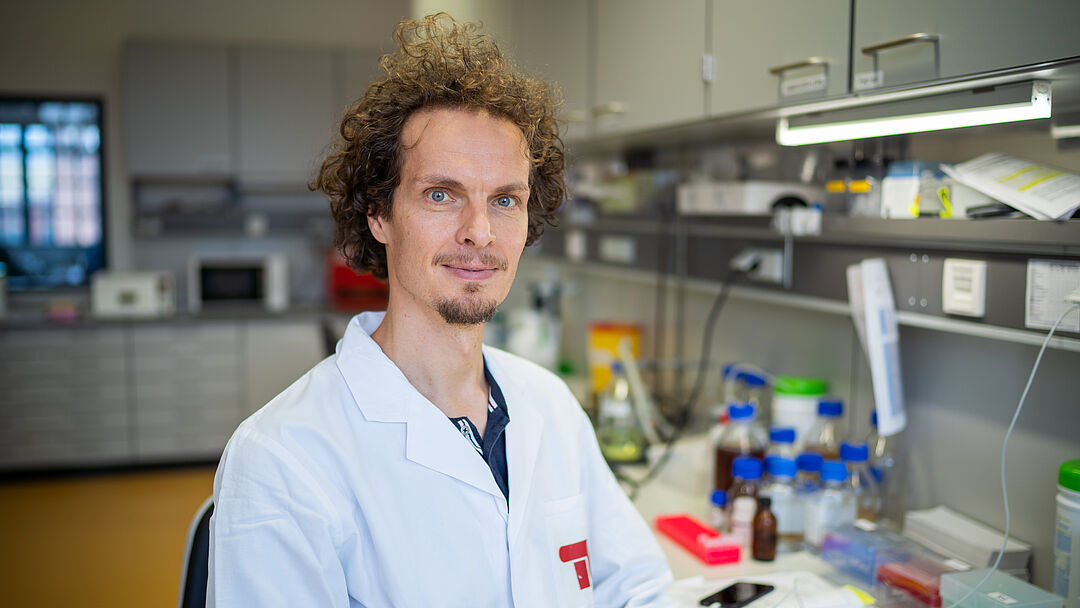“Magic dwells in each beginning" - and also a lot of effort, Mr. Hesse!
Prof. Dr. Juri Rappsilber, Einstein Professor of Bioanalytics, sees opportunities for experimental teaching formats through digitalization
In the summer semester of 2020, German universities had to suddenly switch from face-to-face to digital teaching. What went well, what went badly?
With my research assistant Christian Forbrig and our tutors, we prepared for a digital semester at a very early point in time - we got started in March 2020. This helped to re-orient ourselves from the outset, instead of waiting hopefully and anxiously. We had also been in dialog with the Center for Scientific Continuing Education and Cooperation (ZEWK) for a while and had been thinking about digitalization concepts together. However, we had put off implementation because of other ongoing tasks. Then, at the start of the digital semester, we distributed the different aspects of our teaching among the team and did our best to really achieve 100 percent of what was possible.
On the technical side, however, a lot went wrong. The time required was immense - we had not considered that. There was also a lot of extra work required on other topics in research and administration because of disrupted routines. In my case, remote schooling for three elementary school-aged children and closed daycare centers for two of my employees were added to the mix. At the end of the summer semester, I was on the verge of burnout and it was clear that we had to approach the winter semester differently in terms of organization.

How did you design the digital winter semester?
We used the Information System for Instructors and Students (ISIS), which is TU Berlin’s e-learning system, as a central information platform. We set the schedule for the semester right at the beginning, giving students weekly learning packages. Together with the tutors, we also put a lot of effort into digitizing the lab. I was very impressed with the result because you could really see all the steps of the experiment, no matter how small, very well and all the details could be addressed. This is in stark contrast to the labs in my early days, where at least half of the students only saw the backs of their fellow students.
Have you tried innovative formats? If so, how did you create them?
During the summer semester, I broke down my large basic lecture into about 15-minute segments, then I recorded and edited them. I had included activating elements and also written text around the clips, with further links. That was a lot of work, about two days a week. I had not enjoyed sitting alone in the basement at all, getting little to no feedback back from the students.
Actually, I wanted to upload my sound recordings from last year for this winter semester and recover from that tour de force, but when I saw how enthusiastic my tutors were I sat down and got started again. This time, however, I'm doing it together with students, and the tutors are recording, too. Just like with face-to-face teaching, I now have my set weekly schedule and look forward to seeing the students who are kind enough to turn on their cameras and join in. The whole thing has a different kind of energy this way. Unlike the recordings from the summer, we are now generating recordings that will be usable even after COVID. The lecture is flanked by a weekly schedule of online quizzes, a student question forum, an assignment sheet, and a seminar. This way, we can offer students the opportunity to get engaged during the semester and to actively acquire the material.
In the master’s program, we did a 5-week block course with Zoom. The commitment of our assistants, the division into teams with breakout rooms, our communication via the messaging service Slack, and the external experts whom we regularly presented what we had learned and who we had intensive discussions with were all very well received.
 © Unsplash/Nikita Kachanovsky
© Unsplash/Nikita Kachanovsky
How did you come up with the formats and digitally suitable content?
We sat down as a team and thought about what could work and how. In the process, we are also willing to try things out. We then consider feedback from our students on how we can further improve the courses. Students also see quite a bit in other courses and find out what works for them.
How much effort went into it - compared to classroom teaching?
In the second digital semester, we were able to draw on an established infrastructure, experience, and expertise. We are also moving more toward digital face-to-face formats that are recorded for asynchronous, or time-shifted, learning. That has made the time required tolerable.
What about online exams?
In our master’s courses, mainly active participation is graded, for example research papers, presentations, and active participation by asking questions and giving feedback to the lecturers. This is now done just as before, only online. For the basic lectures in the bachelor's program, we already switched to electronic exams some time ago. The step to online testing seems like it will be a small one; we are working on it and look forward to the formats to be developed.
What benefits do you see for yourself and the students?
I hear from students that they really appreciate asynchronous learning. For one, it means that they can listen to the content several times. We are also experimenting a lot with different teaching and learning formats to engage students more. To this end, we ask for their feedback and adapt the formats accordingly even in the ongoing semester, if possible. This also involves the students. We hope this will lead to additional interest in our subject.
And what are the disadvantages?
“Magic dwells in each beginning" - and also a lot of effort, Mr. Hesse. In terms of technical implementation but also in terms of student engagement, we are in the process of developing new routines. With the experience we gained during the summer, we are doing much better this winter semester. We are working towards meeting our own teaching aspirations both digitally and in presence. I am optimistic that digital elements will lead to better teaching in the long term.
Is there also something lost in digital courses?
I miss being able to look students in the eye. I always found it tremendously motivating to see their interested expressions. Questioning looks or blank stares, on the other hand, are clear signs that more explanation needs to be given. Asynchronous feedback via forums or teaching evaluations cannot replace this. I hope that Q&A sessions help make things fun again.
What will you take with you into the new era?
We have always experimented with teaching and learning formats and will continue to do so. The lecture will probably remain digital. I will invest the time saved there in the future in more interactive formats, which I am already looking forward to testing. I also find it exciting to see our team's strengths in the crisis. This is something we can continue to build on in the future.
Interviewer: Christina Camier
